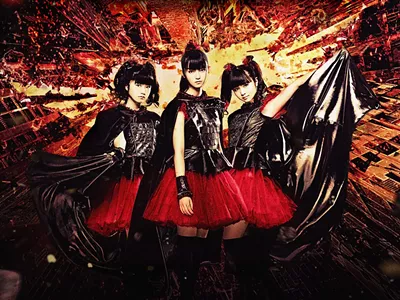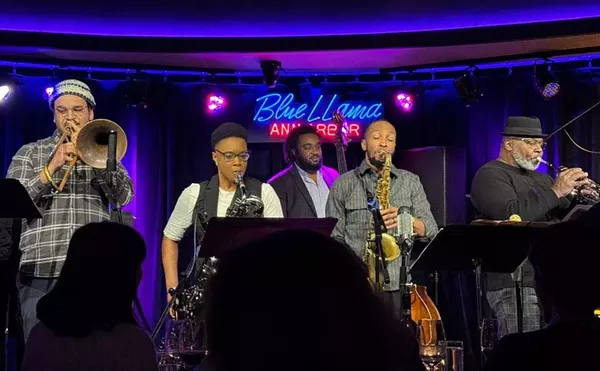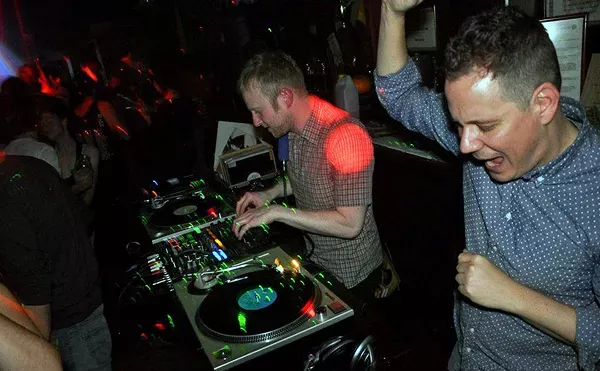I'm going to go out on a limb and guess that you might have heard of the Beatles? People like to call them "lads" and "mop tops from Liverpool"? The Henry Ford Museum is now hosting a traveling exhibit of Beatles memorabilia called "Magical History Tour." The Beatles are best known today for helping to launch the amazing career of Yoko Ono, of course (insert smiley-faced emoticon). But thousands of other bands have been immensely influenced by their dozens of stylistic phases and the quirky approach they took to their impossible stardom. As this show helps to demonstrate in its size and scope, you could never replicate the Beatles' impact on the world at large, any more than one could the replicate the impact of Elvis Presley, Marilyn Monroe, Andy Warhol, or Genghis Khan.
A brick-by-brick re-creation of the Cavern Club — replete with period instruments, amplifiers, and scratched graffiti — is the standout of the exhibit. "My favorite part of the show is the creation of the environments of the Cavern Club in Liverpool, England, where members of the Beatles first performed under John Lennon in 1956," says John Neilson, Henry Ford's senior director of museum and attractions. "The Beatles made their first appearance at the club in February 1961 after returning to Liverpool from Hamburg, Germany, where they had been playing at similar clubs. From 1961 to 1963, the Beatles made nearly 300 appearances at the club, their last occurring in the summer of 1963 — six months before the Beatles' first trip to the U.S. They really coalesced as a group in this period [when] 'Beatlemania' was sprouting across England. This was the end of one era; the small club of their early years could no longer satisfy audience demands."
This self-described "most exhaustive Beatles exhibition ever assembled" opened on April 30 and is up until Sept. 18. These artifacts can have a shards-of-the-true-cross feel to them, especially the one-of-a-kind objects. This can spur deep feelings of devotion and reverence in the heart of even the most casual fan. Conversely, when you reflect that such museum showings are sure to help to increase each object's monetary value, it's easy to be a little skeptical. A Google search of auction results for some of these items shows that Beatle memorabilia remains very much a growth industry.
Traveling shows that don't originate from a visionary institution such as the Walker or Whitney can be a bit lackluster, especially if they're pop culture affairs. They can lack the immediacy and curatorial panache of a show originating from within and for one institution.
"Magical Mystery Tour" is bright, fresh, and rewarding enough, though. It's very much worth a visit, and you wouldn't guess it traveled from the U.K. to get here. The requisite, contemporary, immersive, and interactive bells and whistles are attached to the exhibit. There is one piece from the traveling show that didn't make it to Dearborn: a bright, psychedelically painted Rolls Royce. "The Lennon Rolls Royce was here for the first Rock Stars, Cars & Guitars in 2007, which is why we didn't bring it in for this show," Neilson says.
I'm frequently surprised that so few locals realize that the Henry Ford Museum's collection is nearly as wide-ranging as the Smithsonian's, that it in fact has tens of thousands of amazing items in its collection from a variety of cultural, historical, artistic, and scientific epochs and realms of study. The Henry Ford could have put together their own Beatles show, themselves. And it would have been more than adequate, simply from their own holdings.
"We do have some Beatles-related items; you can find them on our artifact site," Melissa Foster, the Henry Ford's media and film relations manager, says. "We actually wrote about them online last year in honor of the 50th anniversary of Beatlemania. The items in our collection are very similar to those featured in the exhibit; they highlight the frenzy the Beatles created when they first came to America, and the mass marketing of the band, from souvenir buttons to lunchboxes."
Some of the items are pretty sad. Their actual breakup letter is here, but as nothing more than a letter sent to Paul McCartney's lawyer, it's more a weird curio than a sock to the gut. For true emotional impact, we turn to an LP behind glass with two people kissing on the cover. "One of the most poignant, yet challenging artifacts in the show is John Lennon's last autograph, on the Double Fantasy album cover," Neilson says. This morbid album was sold at auction six years ago for reportedly close to $1 million. It had previously sold for at least $525,000 in 2003; and in 1999, for $150,000.
Lennon "signed it for Mark Chapman, the individual who killed him just hours later," Neilson says. "It may be a difficult piece to see, given its haunting reminders of a life and talent taken from us too soon. The experience ends with this artifact and the difficult story it has to share. When I think about those early years of the group, how they came together, of their successes, and long-term impact of their music, this artifact at the conclusion of the show really brought it home for me, as it was the end of their music together that had so impacted the world."
"Magical History Tour" runs through Sept. 18 at the Henry Ford Museum; Open daily 9:30 a.m.- 5 p.m.; 20900 Oakwood, Dearborn; 313-982-6001; thehenryford.org; Tickets are $5, plus regular museum admission ($21 adults, $15.75 youths, children free, and $19 seniors; parking is $6).








